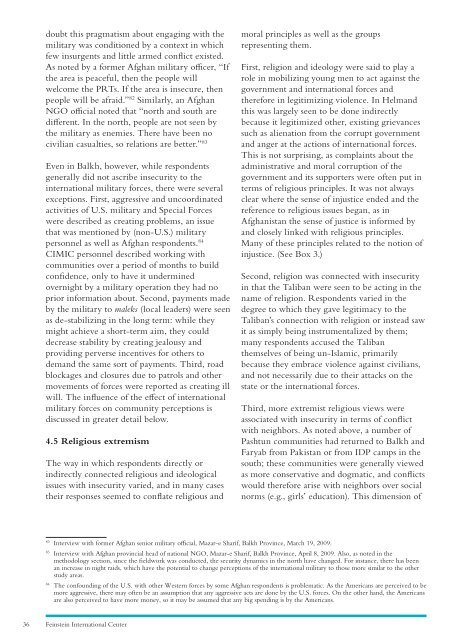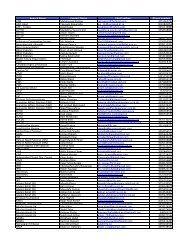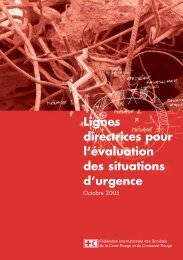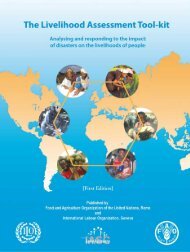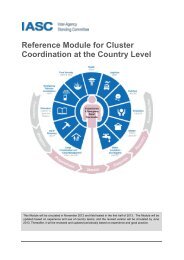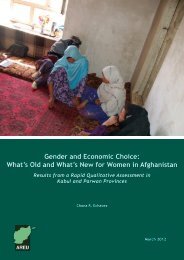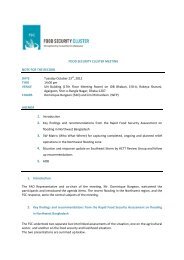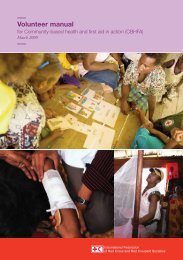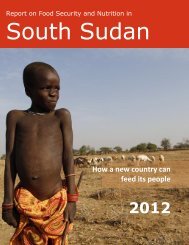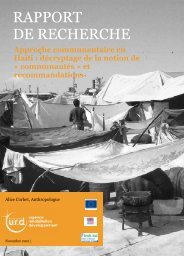Winning Hearts and Minds? - Tufts - Tufts University
Winning Hearts and Minds? - Tufts - Tufts University
Winning Hearts and Minds? - Tufts - Tufts University
Create successful ePaper yourself
Turn your PDF publications into a flip-book with our unique Google optimized e-Paper software.
doubt this pragmatism about engaging with themilitary was conditioned by a context in whichfew insurgents <strong>and</strong> little armed conflict existed.As noted by a former Afghan military officer, “Ifthe area is peaceful, then the people willwelcome the PRTs. If the area is insecure, thenpeople will be afraid.” 82 Similarly, an AfghanNGO official noted that “north <strong>and</strong> south aredifferent. In the north, people are not seen bythe military as enemies. There have been nocivilian casualties, so relations are better.” 83Even in Balkh, however, while respondentsgenerally did not ascribe insecurity to theinternational military forces, there were severalexceptions. First, aggressive <strong>and</strong> uncoordinatedactivities of U.S. military <strong>and</strong> Special Forceswere described as creating problems, an issuethat was mentioned by (non-U.S.) militarypersonnel as well as Afghan respondents. 84CIMIC personnel described working withcommunities over a period of months to buildconfidence, only to have it underminedovernight by a military operation they had noprior information about. Second, payments madeby the military to maleks (local leaders) were seenas de-stabilizing in the long term: while theymight achieve a short-term aim, they coulddecrease stability by creating jealousy <strong>and</strong>providing perverse incentives for others todem<strong>and</strong> the same sort of payments. Third, roadblockages <strong>and</strong> closures due to patrols <strong>and</strong> othermovements of forces were reported as creating illwill. The influence of the effect of internationalmilitary forces on community perceptions isdiscussed in greater detail below.4.5 Religious extremismThe way in which respondents directly orindirectly connected religious <strong>and</strong> ideologicalissues with insecurity varied, <strong>and</strong> in many casestheir responses seemed to conflate religious <strong>and</strong>moral principles as well as the groupsrepresenting them.First, religion <strong>and</strong> ideology were said to play arole in mobilizing young men to act against thegovernment <strong>and</strong> international forces <strong>and</strong>therefore in legitimizing violence. In Helm<strong>and</strong>this was largely seen to be done indirectlybecause it legitimized other, existing grievancessuch as alienation from the corrupt government<strong>and</strong> anger at the actions of international forces.This is not surprising, as complaints about theadministrative <strong>and</strong> moral corruption of thegovernment <strong>and</strong> its supporters were often put interms of religious principles. It was not alwaysclear where the sense of injustice ended <strong>and</strong> thereference to religious issues began, as inAfghanistan the sense of justice is informed by<strong>and</strong> closely linked with religious principles.Many of these principles related to the notion ofinjustice. (See Box 3.)Second, religion was connected with insecurityin that the Taliban were seen to be acting in thename of religion. Respondents varied in thedegree to which they gave legitimacy to theTaliban’s connection with religion or instead sawit as simply being instrumentalized by them;many respondents accused the Talibanthemselves of being un-Islamic, primarilybecause they embrace violence against civilians,<strong>and</strong> not necessarily due to their attacks on thestate or the international forces.Third, more extremist religious views wereassociated with insecurity in terms of conflictwith neighbors. As noted above, a number ofPashtun communities had returned to Balkh <strong>and</strong>Faryab from Pakistan or from IDP camps in thesouth; these communities were generally viewedas more conservative <strong>and</strong> dogmatic, <strong>and</strong> conflictswould therefore arise with neighbors over socialnorms (e.g., girls’ education). This dimension of82Interview with former Afghan senior military official, Mazar-e Sharif, Balkh Province, March 19, 2009.83Interview with Afghan provincial head of national NGO, Mazar-e Sharif, Balkh Province, April 8, 2009. Also, as noted in themethodology section, since the fieldwork was conducted, the security dynamics in the north have changed. For instance, there has beenan increase in night raids, which have the potential to change perceptions of the international military to those more similar to the otherstudy areas.84The confounding of the U.S. with other Western forces by some Afghan respondents is problematic. As the Americans are perceived to bemore aggressive, there may often be an assumption that any aggressive acts are done by the U.S. forces. On the other h<strong>and</strong>, the Americansare also perceived to have more money, so it may be assumed that any big spending is by the Americans.36Feinstein International Center


